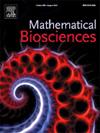血管肿瘤生长的趋化效应:相场模型与模拟
IF 1.8
4区 数学
Q2 BIOLOGY
引用次数: 0
摘要
在本文中,我们提出了一种结合了相场肿瘤模型和相场血管生成模型的血管肿瘤生长模型。通过结合不同的肿瘤细胞种类,我们捕捉到了肿瘤在不断发展的新血管中的不稳定性。该模型不仅考虑了肿瘤细胞相位转换、运动和压力效应的不同动态,还全面呈现了血管生成,包括内皮细胞的趋化、发芽、吻合和毛细血管中的血流。本研究评估了在无血管和有血管肿瘤生长情况下趋化对肿瘤细胞移动的影响。结果表明,当血管生成受到刺激时,肿瘤会加速生长。此外,研究还探讨了肿瘤与邻近血管的各种初始距离,揭示了一个临界阈值距离,超过该距离,血管生成因子将无法刺激血管生成,从而导致肿瘤保持稳定状态。将趋化作用纳入生长模型会诱发不稳定性,导致营养供应增加,肿瘤生长速度加快。此外,研究认为抗血管生成疗法是一种理想的方法,假定从早期阶段就能完全抑制血管生成。在这种情况下,肿瘤会持续处于稳定状态,在没有新生血管的情况下保持无血管的大小极限。相反,如果考虑到趋化作用,抗血管生成疗法就会失去效率,使肿瘤无限制地向邻近血管生长。这项研究揭示了血管性肿瘤生长过程中趋化、血管生成和抗血管生成疗法之间错综复杂的相互作用,为开发靶向治疗策略提供了宝贵的见解。本文章由计算机程序翻译,如有差异,请以英文原文为准。
Chemotaxis effects on the vascular tumor growth: Phase-field model and simulations
In this paper, we propose a vascular tumor growth model that combines a phase-field tumor model with a phase-field angiogenesis model. By incorporating various tumor cell species, we capture the instabilities of the tumor in the presence of evolving neovasculature. The model not only considers different dynamics of tumor cell phase conversions, movement, and pressure effects but also provides a comprehensive representation of angiogenesis, encompassing chemotaxis of endothelial cells, sprouting, anastomoses, and blood flow in capillaries. This study evaluates the impact of chemotaxis on tumor cell movement in both avascular and vascular tumor growth scenarios. The results highlight the acceleration of tumor growth when angiogenesis is stimulated. Additionally, the investigation explores various initial distances of the tumor from neighboring vessels, revealing a critical threshold distance beyond which the angiogenesis factor fails to stimulate angiogenesis, resulting in the tumor maintaining a stable state. The integration of chemotaxis into the growth model induces instabilities, leading to increased nutrient availability and faster growth for the tumor. Furthermore, the study considers anti-angiogenesis therapy as an ideal approach, assuming complete inhibition of angiogenesis from the early stages. In this scenario, the tumor persists in a steady state, adhering to the avascular size limit in the absence of neovasculature. Conversely, when considering chemotaxis, anti-angiogenesis therapy loses efficiency, enabling unrestrained tumor growth towards neighboring vessels. This work sheds light on the intricate interplay among chemotaxis, angiogenesis, and anti-angiogenesis therapy in the context of vascular tumor growth, providing valuable insights for the development of targeted treatment strategies.
求助全文
通过发布文献求助,成功后即可免费获取论文全文。
去求助
来源期刊

Mathematical Biosciences
生物-生物学
CiteScore
7.50
自引率
2.30%
发文量
67
审稿时长
18 days
期刊介绍:
Mathematical Biosciences publishes work providing new concepts or new understanding of biological systems using mathematical models, or methodological articles likely to find application to multiple biological systems. Papers are expected to present a major research finding of broad significance for the biological sciences, or mathematical biology. Mathematical Biosciences welcomes original research articles, letters, reviews and perspectives.
 求助内容:
求助内容: 应助结果提醒方式:
应助结果提醒方式:


